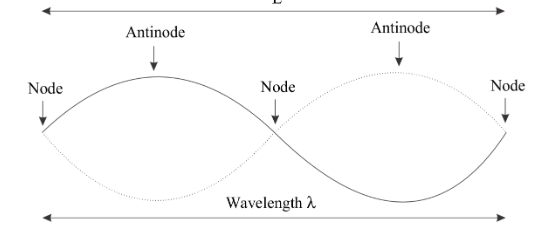
Draw a sketch that shows the standing waves pattern.
Answer
532.5k+ views
Hint:Draw the wave pattern of a standing wave. Discuss about the node, antinode and relation between a fixed string length with the wavelength of the vibrating string. Explain about the region where the disturbances are maximum and minimum.
Complete step by step solution:
Standing wave pattern is a vibrational pattern created within a medium when the vibrational frequency of the source causes reflected waves from one end of the medium to interfere with incident waves from the source. Basically standing wave when the wave does not propagate, just sits there vibrating up and down in a fixed place.

Standing waves remain fixed in a place, but they have regions where the amplitude of the wave is very small, almost zero. These locations are called nodes. These points in the wave pattern appear to be standing still. Nodes are sometimes described as points of no displacement.
There are also regions where the disturbance is maximum, greater than anywhere else in the medium, called antinodes.
Standing wave patterns are always expressed with an alternating pattern of nodes and antinodes.
For a standing wave on a string of length $L$ with two fixed ends is $L = \dfrac{{n\lambda }}{2}$ where $n = 1,2,3 \cdot \cdot \cdot $
Note:Standing waves can be formed under various conditions, but they are easily demonstrated in a finite or bounded medium. Any system of standing waves can produce various natural frequencies. The lowest frequency of a standing wave having least number of nodes and antinodes is called fundamental frequency.
Complete step by step solution:
Standing wave pattern is a vibrational pattern created within a medium when the vibrational frequency of the source causes reflected waves from one end of the medium to interfere with incident waves from the source. Basically standing wave when the wave does not propagate, just sits there vibrating up and down in a fixed place.

Standing waves remain fixed in a place, but they have regions where the amplitude of the wave is very small, almost zero. These locations are called nodes. These points in the wave pattern appear to be standing still. Nodes are sometimes described as points of no displacement.
There are also regions where the disturbance is maximum, greater than anywhere else in the medium, called antinodes.
Standing wave patterns are always expressed with an alternating pattern of nodes and antinodes.
For a standing wave on a string of length $L$ with two fixed ends is $L = \dfrac{{n\lambda }}{2}$ where $n = 1,2,3 \cdot \cdot \cdot $
Note:Standing waves can be formed under various conditions, but they are easily demonstrated in a finite or bounded medium. Any system of standing waves can produce various natural frequencies. The lowest frequency of a standing wave having least number of nodes and antinodes is called fundamental frequency.
Recently Updated Pages
Class 11 Question and Answer - Your Ultimate Solutions Guide

Master Class 11 Accountancy: Engaging Questions & Answers for Success

Master Class 11 Physics: Engaging Questions & Answers for Success

Master Class 11 Business Studies: Engaging Questions & Answers for Success

Master Class 11 Maths: Engaging Questions & Answers for Success

Master Class 11 Chemistry: Engaging Questions & Answers for Success

Trending doubts
1 ton equals to A 100 kg B 1000 kg C 10 kg D 10000 class 11 physics CBSE

Difference Between Prokaryotic Cells and Eukaryotic Cells

One Metric ton is equal to kg A 10000 B 1000 C 100 class 11 physics CBSE

What is the opposite of entropy class 11 chemistry CBSE

Proton was discovered by A Thomson B Rutherford C Chadwick class 11 chemistry CBSE

1 Quintal is equal to a 110 kg b 10 kg c 100kg d 1000 class 11 physics CBSE




